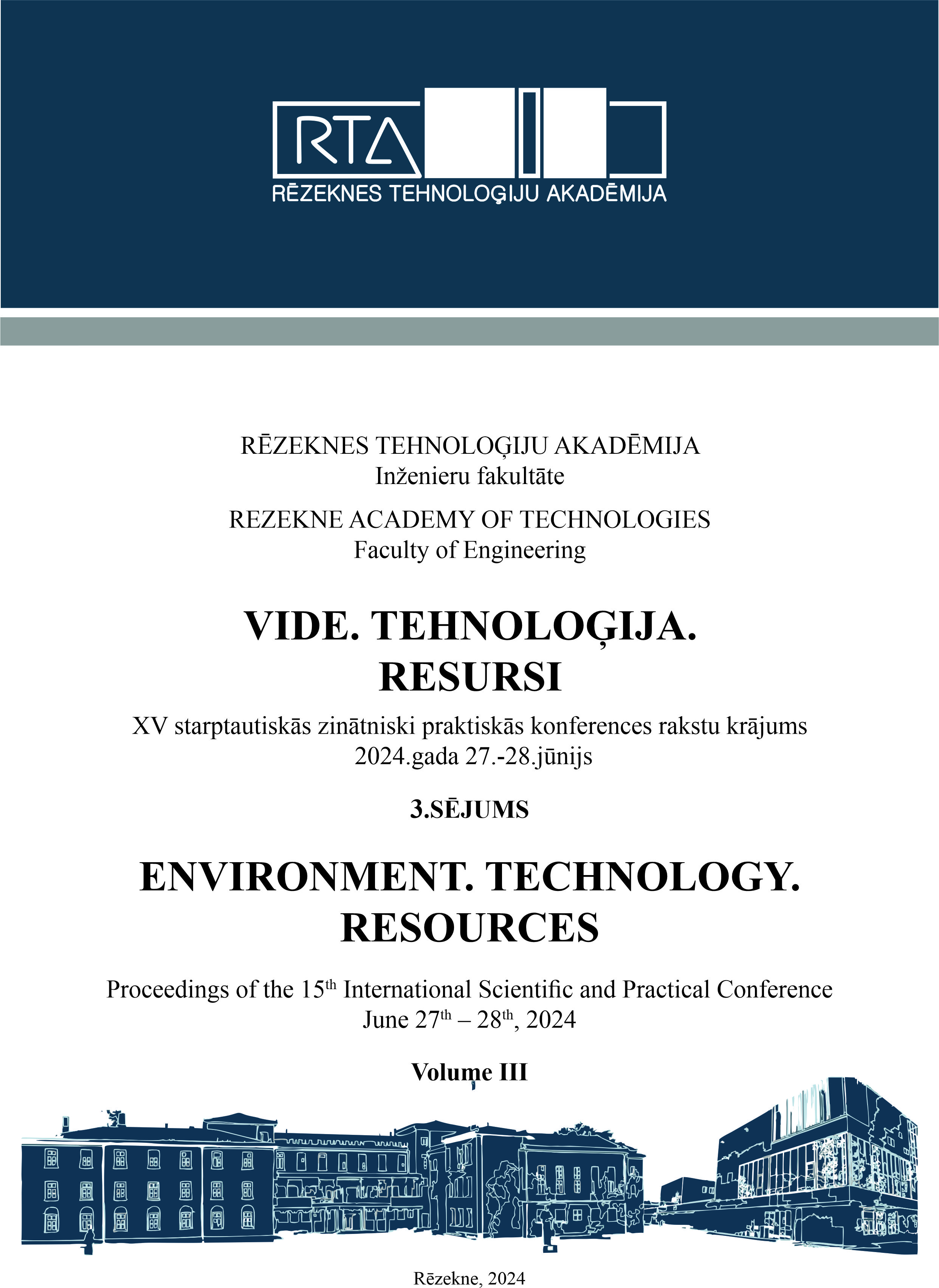MATHEMATICAL MODEL EQUATION OF THE ENERGY WILLOW CUTTING UNLOADING PROCESS FROM THE SLOT HOPPER AUTOMATED PLANTER
DOI:
https://doi.org/10.17770/etr2024vol3.8102Keywords:
unloading of cuttings, energy willow, mathematical model, Navier–Stokes equation, Laplace transform, calculation equationsAbstract
This work is a logical continuation of the authors’ cycle of works devoted to construction of a mathematical model of the unloading process of cuttings from a slotted hopper. The purpose of the paper is a theoretical justification of the movement of an array of cuttings during gravity unloading. The article proposes consideration of the process of unloading the energy willow cuttings from the point of view of hydrodynamic multiphase systems. It is suggested to consider the set of cuttings as a pseudo-fluid consisting of two phases: discrete (cuttings) and continuous (air). Each of these phases can be considered as a continuous environment. Under such conditions, the task is reduced to consideration of the cuttings' discharge as the movement of a viscous non-contacting pseudo-liquid. Under such assumptions, the velocity field of the set of cuttings can be characterized by the Navier-Stokes equation, the solution of which will allow forming of an algorithm for building a mathematical model of the motion of such pseudo-fluid and moving to the calculation equations of the motion with initial and boundary conditions.
Downloads
References
M.V. Roik, V.M. Sinchenko, Y.D. Fuchylo. Energety`chna verba: texnologiya vy`roshhuvannya ta vy`kory`stannya [Energy willow: cultivation technology and usage]., Vinnitsa: LLC “Nilan-LTD”, 2015 (in Ukrainian)
J. Frączek, K.. Mudryk. Jakości sadzonek wierzby energetycznej w aspekcie sadzenia mechanicznego [The quality of energy willow seedlings in terms of mechanical planting]. Inżynieria Rolnicza, 6 (66), 2005 (in Polish)
S. Yermakov, T. Hutsol, S. Slobodian, S.Komarnitskyi, M. Tysh,. Possibility of using automation tools for planting of the energy willow cuttings. Renewable Energy Sources: Engineering, Technology, Innovation. 2018, pp. 419–429. https://doi.org/10.1007/978-3-030-13888-2_42
R.N. Mynko. Problema svodoobrazovanyia v emkostiakh bunkernoho tipa v uslovyiakh dlitelnoho khraneniya [The problem of arch formation in bunker-type tanks under long-term storage conditions]. Yaroslavskyi pedahohycheskyi vestnyk, 3(1). 2017.(in Russian)
V.S. Loveikin, L.S. Shymko, V.V. Yaroshenko. Ohliad doslidzhen vytoku sypkykh materialiv [Review of research on the leakage of bulk materials]. Kon-struiuvannia, vyrobnytstvo ta ekspluatatsiia silskohospodarskykh mashyn [Design, manufacture and operation of agricultural machinery], 40(1), 2010, pp.324–333. (in Ukrainian).
U. Nedilska, A. Rud, O. Kucher, O. Dumanskyi. Bioenergetic evaluation of miscanthus giant roductivity in the conditions of the western forest-steppe of Ukraine for use as a solid. Engineering for rural development. Jelgava, 2023, pp.1017-1025.
G.A. Geniev. Dinamika plasticheskoj i sypuchej sred. [Dynamics of plastic and granular media]. Moskva. 1972 (in Russian)
Y.V. Horiushynskyi. Emkosty dlia sypuchikh gruzov v transportno-hruzovykh sistemakh [Tanks for bulk cargo in transport and cargo systems]. Samara: SamHAPS. 2003 (in Russian)
L.V. Gjachev. Osnovy teorii bunkerov [Fundamentals of hopper theory]. Novosibirsk: Izd-vo Novosibirskogo universiteta. 1992 (in Russian)
I.S. Aranson, L.S. Tsimring. Patterns and collective behavior in granular media: Theoretical concepts. Reviews of modern physics, 78(2), 2006, pp.641-692.
A.M. Dalskiy. Spravochnik tehnologa-mashinostroitelya [Reference book of machine technologist-builder]. Moskow: Mashinostroenie. 2001. (in Russian).
V.N. Dolgunin, V.Ya. Borschev. Bystryie gravitatsionnyie techeniya zern-istyih materialov: tehnika izmereniya, zakonomernosti, tehnologicheskoe prime-nenie [Rapid gravitational flows of grainy materials: technique of measuring, con-formity to law, technological application]. Moskow: Mashinostroenie. 2005. (in Russian).
M. Korchak, T. Hutsol, L. Burko, W. Tulej. Features of weediness of the field by root residues of corn Vide. Tehnologija. Resursi - Environment, Technology, Resources, V. 1, 2021. pp. 122–126
A. Samadani, A. Pradham, A. Kudrolli. Size segregation of granular matter in silo discharges. Phys Rev E 1999. 7203-9.
V.V. Sokolovskiy. Statika syipuchey sredyi [Statics of friable environment]. Moskow, Nauka. 1990 (in Russian).
R.M. Nedderman. Statics and kinematics of granular materials. Cambridge: Cambridge University Press; 1992.
G.R. Power. Modelling granular flow in caving mines: large scale physical modelling and full scale experiments. PhD thesis, The University of Queensland, Brisbane; 2004.
S. Yermakov, K. Mudryk, T. Hutsol. The analysis of stochastic processes in unloadingthe energywillow cuttings from the hopper. Environment. Technology. Resources. Rezekne, Latvia. Vol. III. 2019, pp. 249-252, https://doi:10.17770/etr2019vol3.4159.
S. Yermakov, T. Hutsol, I. Gerasymchuk, , Fedirko, P., Dubik, V. (2023). Study of the Unloading and Selection Process of Energy Willow Cuttings for the Creation a Planting Machine. Environment. Technologies. Resources. Proceedings of the In-ternational Scientific and Practical Conference, 3, 271-275. https://doi.org/10.17770/etr2023vol3.7199
S. Yermakov, A. Rud, M. Vusatyi The Distribution Of Cash Expenses For The Creation Of Bioenergy Willow Plantations In Ukraine. Vide. Tehnologija. Resursi - Environment. Technologies. Resources. V.1. Rezekne, Latvia. 2023. Pp. 74-80 https://doi.org/10.17770/etr2023vol1.7191
V. Ivanyshyn, S. Yermakov , T. Ishchenko. Calculation algorithm for the dynamic coefficient of vibro-viscosity and other properties of energy willow cuttings movement in terms of their unloading from the tanker. Renewable Energy Sources, vol. 154, E3S Web of Conferences. 2020, pp. 04005, https://doi:10.1051/e3sconf/202015404005 .
S.V. Yermakov, T.D. Hutsol. Features of the heterogeneous rood-like mate-rials outflow (by example of energy willow cutting). Technological and methodo-logical aspects of agri-food engineering in young scientist research. 2018. Pp.55–68.
S. Yermakov, T. Hutsol, O. Ovcharuk, I. Kolosiuk. Mathematic simulation of cutting unloading from the bunker. Independent journal of management & produc-tion. Special Edition PDATU, 10, 758–777; 2019. 2236-269X. https://doi.org/10.14807/IJMP.V10I7.909.
S. Yermakov. Application of the Laplace transform to calculate the velocity of a two-phase fluid modulated by the movement of cuttings of an energy willow (Salix Viminalis). Теka. Quarterly journal of agri-food industry. 2. 2019. 71–78.
V. Maksimenko, V. Kuzmenko, L. Shymko, V. Achkevych. Justification of accelerator parameters of feeding harvester unloading channel. Engineering for Rural Development, 20, 2021. Pp.1534–1540
M.A. Lavrentev. Metody i teorii funktsiy kompleksnogo peremennogo [Meth-ods of the theory of functions of a complex variable]. Moskow: Izdatelstvo fIziko-matematicheskoy lit. 1958. (in Russian).
N.N. Bogolyubov. Asimptoticheskie metodyi v teorii nelineynyih kolebaniy [Asymptotic methods in the theory of nonlinear oscillations]. Moskow: Nauka. 1974
Downloads
Published
Issue
Section
License
Copyright (c) 2024 Serhii Yermakov, Taras Hutsol, Iryna Mushenyk, Stepan Zamojskij, Oleksandr Hovorov

This work is licensed under a Creative Commons Attribution 4.0 International License.



